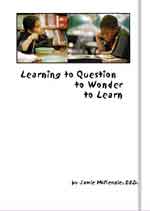|
|
| Vol 15|No 4|June|2006 | |
| Please feel free to e-mail this article to a friend, a principal, a parent, a colleague, a teacher librarian, a college professor, a poet, a magician, a vendor, an artist, a juggler, a student, a news reporter or anyone you think might enjoy it. | |
The Technology Treadmillby Jamie McKenzie
Why would someone prefer a run on a treadmill over a run outdoors? The photographs on the right were shot during an early morning run in Singapore when the humidity and the heat of the rising sun were impressive. Running in the hotel fitness center offered air conditioning, TV screens and a machine to keep track of calories burned, miles covered and one's heart rate. The machine could simulate hills and force the pace to maximize benefits. With the right head phones, the sound of footfalls could be muffled by the latest rap or rock. The treadmill offers convenience and insulation (from reality). The high tech features are seductive and appealing, but surrender to the treadmill is a metaphor for modern life. Habitual surrender to the treadmill can signal acceptance of virtual reality and artificial intelligence when the real thing might be superior. Instead of weaving our way into neighborhoods rarely seen by tourists, we might climb aboard the treadmill and remain within the confines of our hotel. We watch world news on CNN as we jog along upon our rubber band missing the world outside, the monkeys, the Polo Club and the road curving through the canopied hills. |
|
|
Ironically, few treadmills offer wind to cool the body and speed evaporation. Sometimes we sweat more on the treadmill than we might on the road. When Technologies Cheapen Life Despite the fanfare, the marketing promises and the hype, new technologies do not always add to the quality of life or improve schooling. Oftentimes they diminish the real experience. Sometimes they cheapen it. At other times they distort or dilute it. Compare the DVD rainforest with the real one. Compare the early morning run through that same forest with an hour on a treadmill. "Reach out and touch someone," urged the telephone company in one ad series, as if a phone conversation could match the beauty of a real hug or caress. We are told to integrate technology throughout the school day as if it were an automatically benign and beneficial addition to the learning of children even though we have scant evidence to support such a notion. We had best be discerning, making use of these new tools only when they enhance learning and do something that justifies the expense involved in acquiring and feeding them. New technologies penetrate nearly all aspects of life these days, whether it be cell phones ringing during a church service or video cameras tracking our movements through school hallways or urban centers. Many of these technology uses are non-consensual, in the sense that no one has chosen the ringing of the phone or the taping of movements. Many others are fully consensual, as we may subscribe to security services for our home or our school that would tape the movements of intruders as well as our own comings and goings. When Technologies Dilute Learning In the past decade new technologies flooded into schools with relatively few questions asked about their impact or worth. It was a presumptive strike. While the amount of information available to students has multiplied dramatically, much of that information is unreliable, biased and poorly organized. Commentators like David Shenk have employed terms such as "data smog" to capture the phenomenon. Without guidance, students may amass huge piles of dross. New technologies all too often have spawned a cut-and-paste culture that rewards mere gathering. At times, entertainment poses as education as students are treated to streaming video or arcade learning environments that ask little of them other than passive viewing. Short Cuts, Wizards and Artificial Intelligence Many technology companies and software producers cultivate surrender to thinkbots of various kinds. "Let us do the thinking for you - the searching, the designing and the inventing." Searching with Google? Feeling lucky? The popular search engine gives us the option of surrendering to the software's better judgment. Try searching for "truth" using Google's Feeling lucky. The results are intriguing. The artificiality of new technologies andf their so-called intelligence is worthy of thought and consideration. In our rush to embrace what is new what are we leaving behind and what are we sacrificing? Schools have a more solemn calling than responding to the trumpets of the market place, the trends of the day and the fashions of the moment. Our real purpose is to safeguard the human qualities of the civilization, raising young ones to question, ponder, wonder and contribute. When new technologies dilute the quality of experience and substitute plastic for real, school leaders and teachers should refuse the offers, challenge the promises and concentrate on what is sound, worthy and proven to make a difference. Credits: The photographs in this article were shot by Jamie McKenzie. |
|
You can read sample chapters and consider the Table of Contents. Click here.

 From Now On
From Now On